Abstract
This review summarizes the biology of Histoplasma capsulatum in relation to a wide variety of corresponding pathologies in histoplasmosis. Features of these disease syndromes can be explained in part by natural variations within the fungal population and adaptations made by individual organisms to specific environments. H. capsulatum grows as mycelia and conidia in the soil; once inhaled, the organism undergoes a dramatic morphological and physiological conversion to a yeast form. The yeasts proliferate within the phagolysosomes of macrophages, using a variety of specific strategies for intracellular survival. Even avirulent strains or variants are able to avoid being killed by macrophages and instead establish inapparent or persistent infections. The ingested avirulent organisms assume enlarged shapes similar in appearance to those seen in histological sections of tissues from patients with histoplasmosis. Respiratory tract epithelial cells also appear to play a role in persistence: within them yeasts undergo phenotypic switching akin to the phase variation observed in other pathogens. This particular change involves the loss or modification of cell wall alpha-(1,3)-glucan, which is also correlated with the spontaneous appearance of avirulent variants. The repertoire of adaptive responses and natural variations within this species probably evolved from the need to adjust to a wide range of dynamic environments. In combination with the immune status of the host, these characteristics of H. capsulatum appear to influence the epidemiology, extent, and persistence of histoplasmosis.
Full text
PDF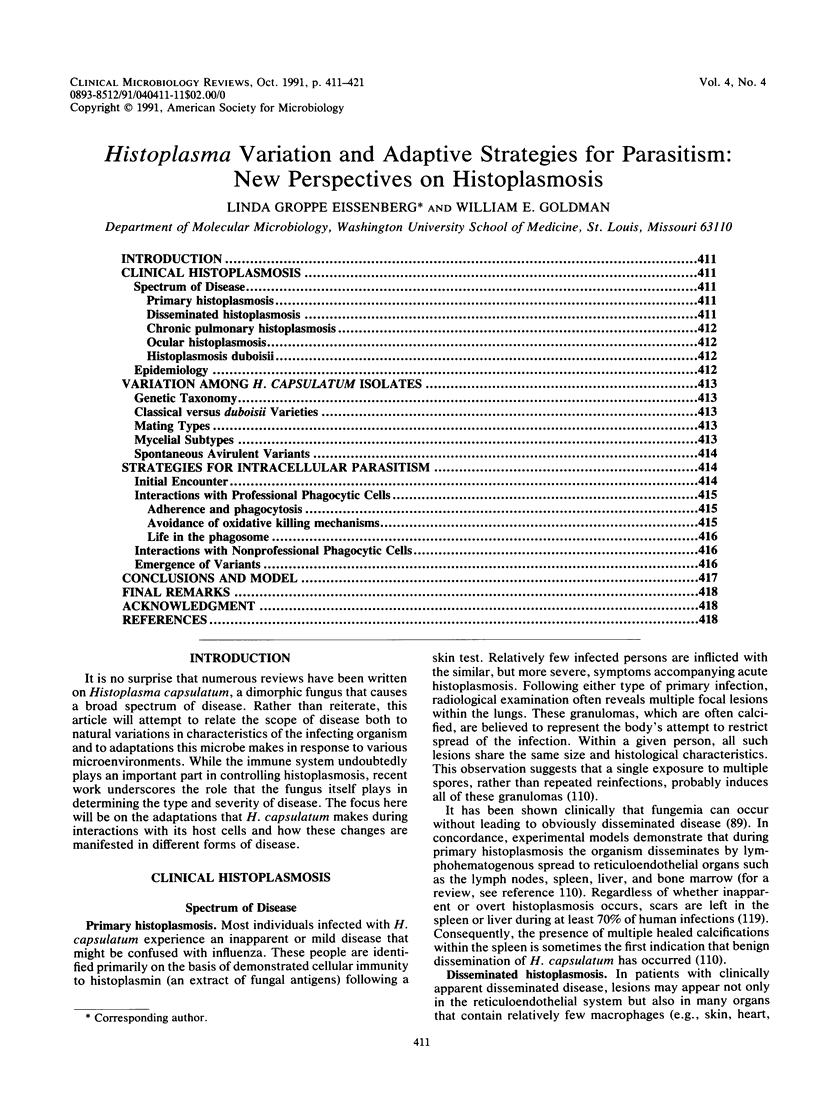

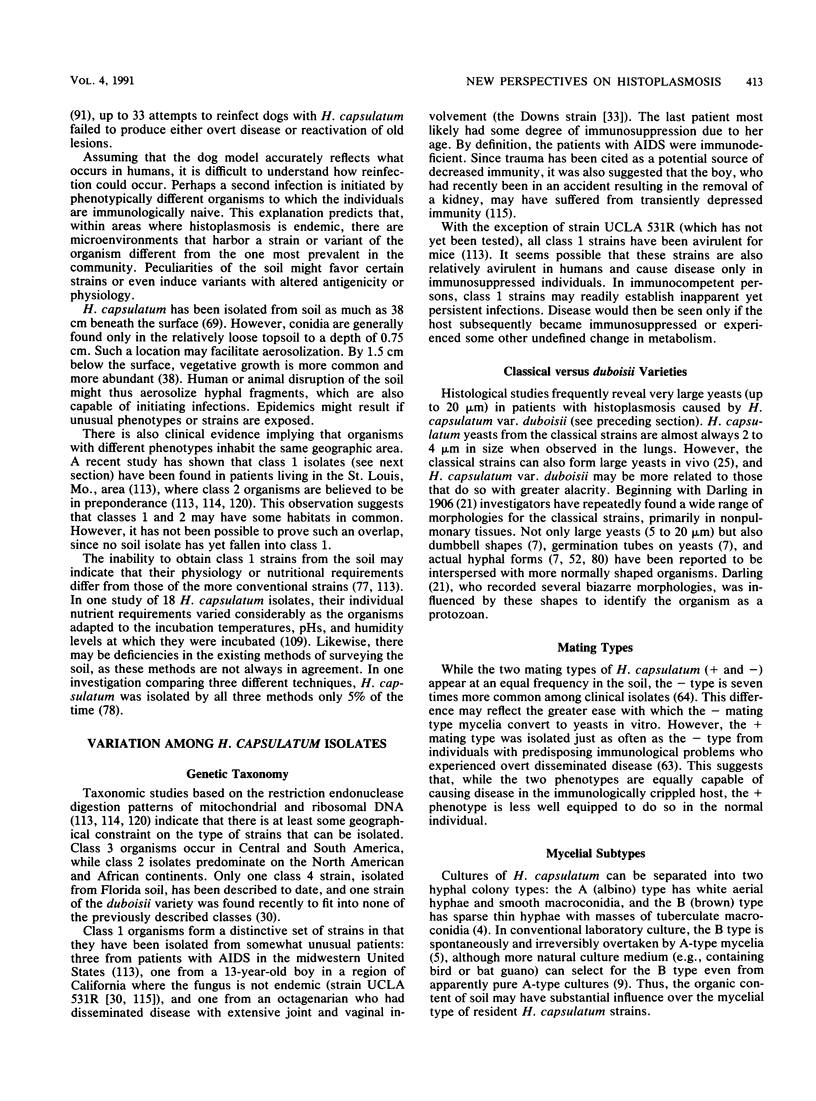
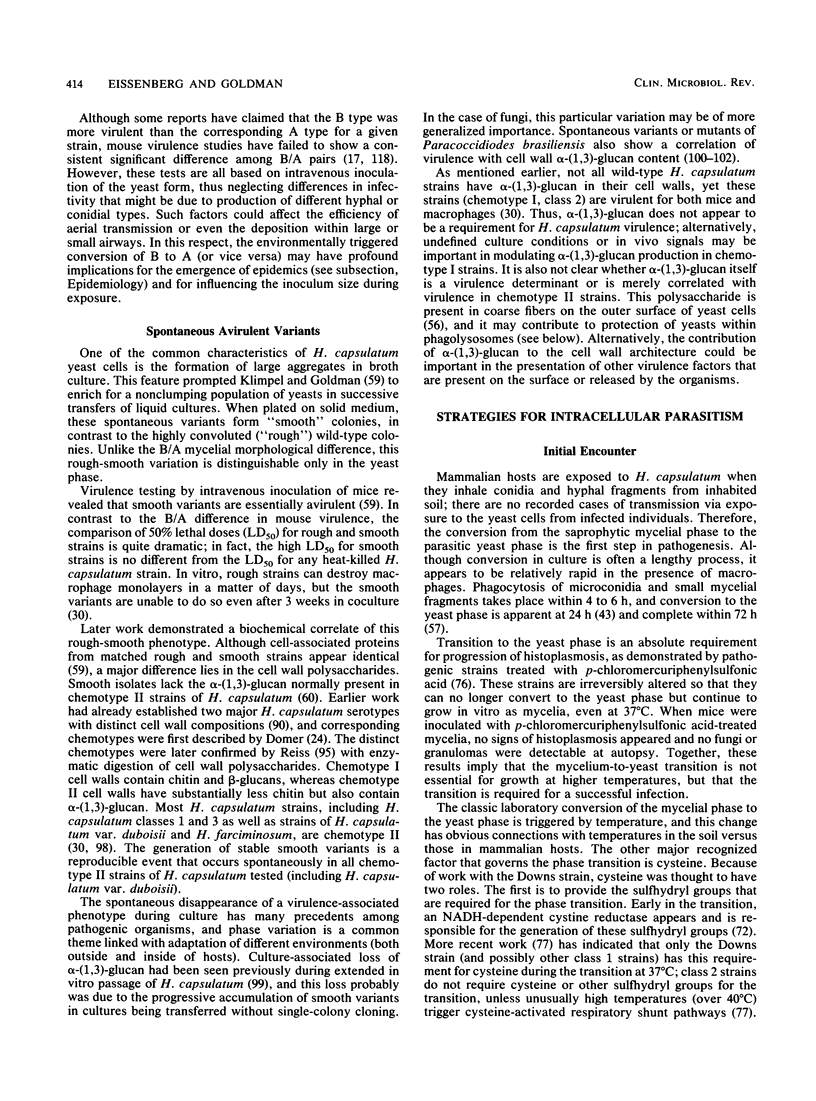
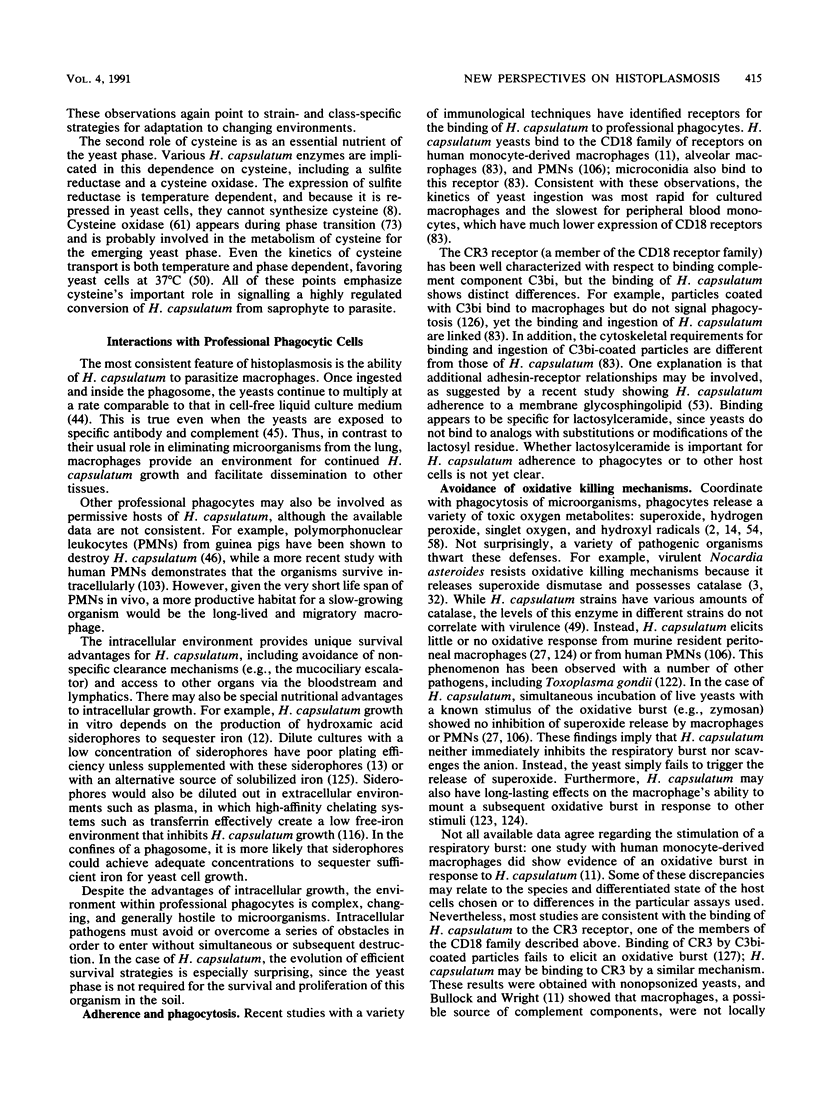
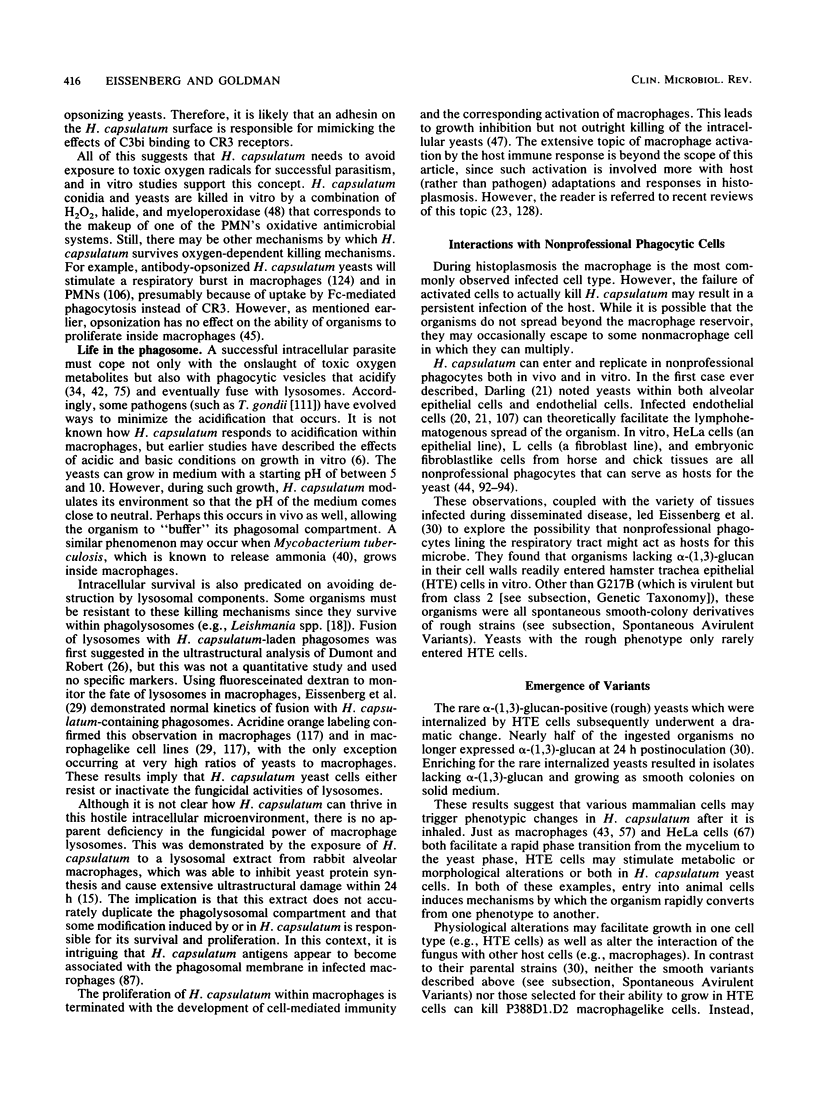
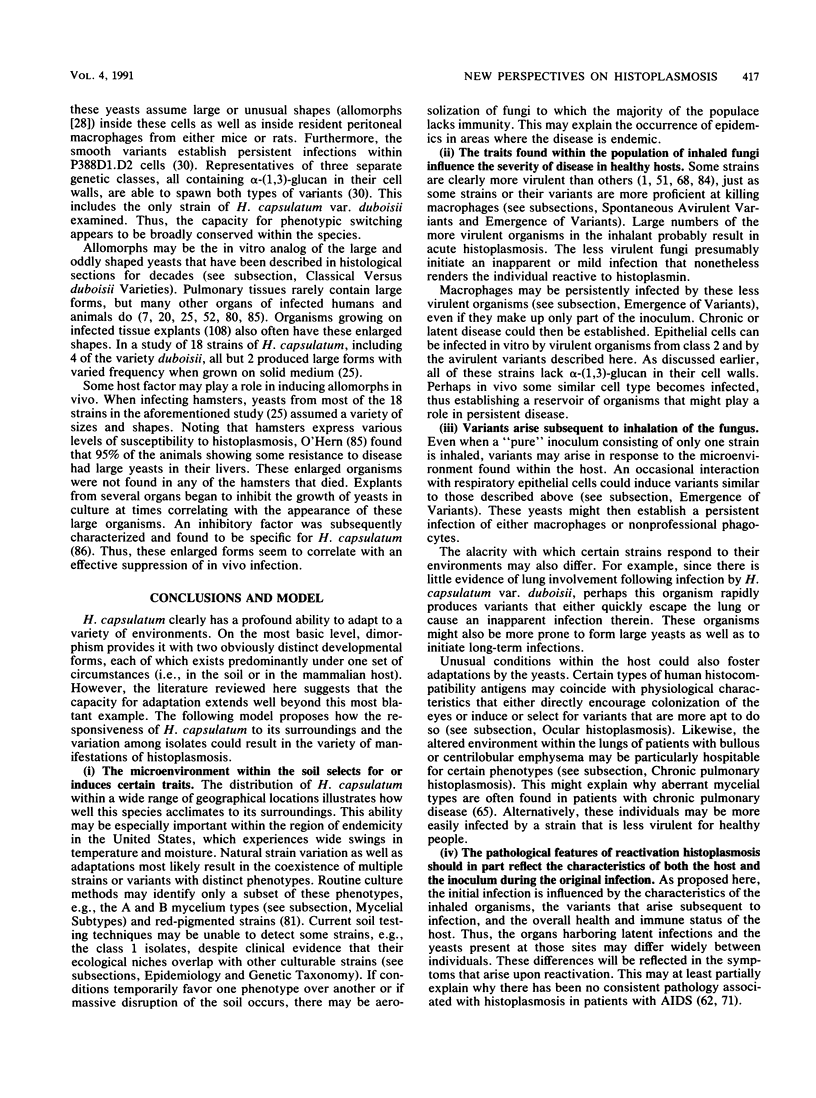

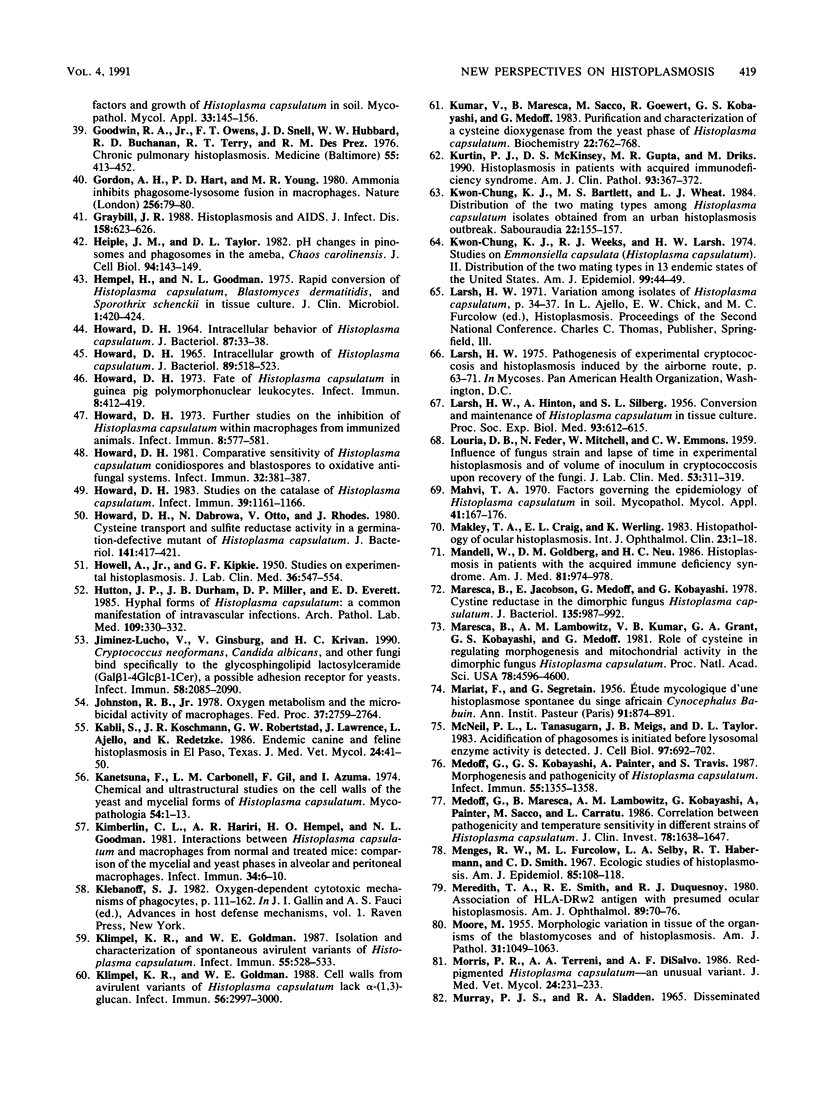
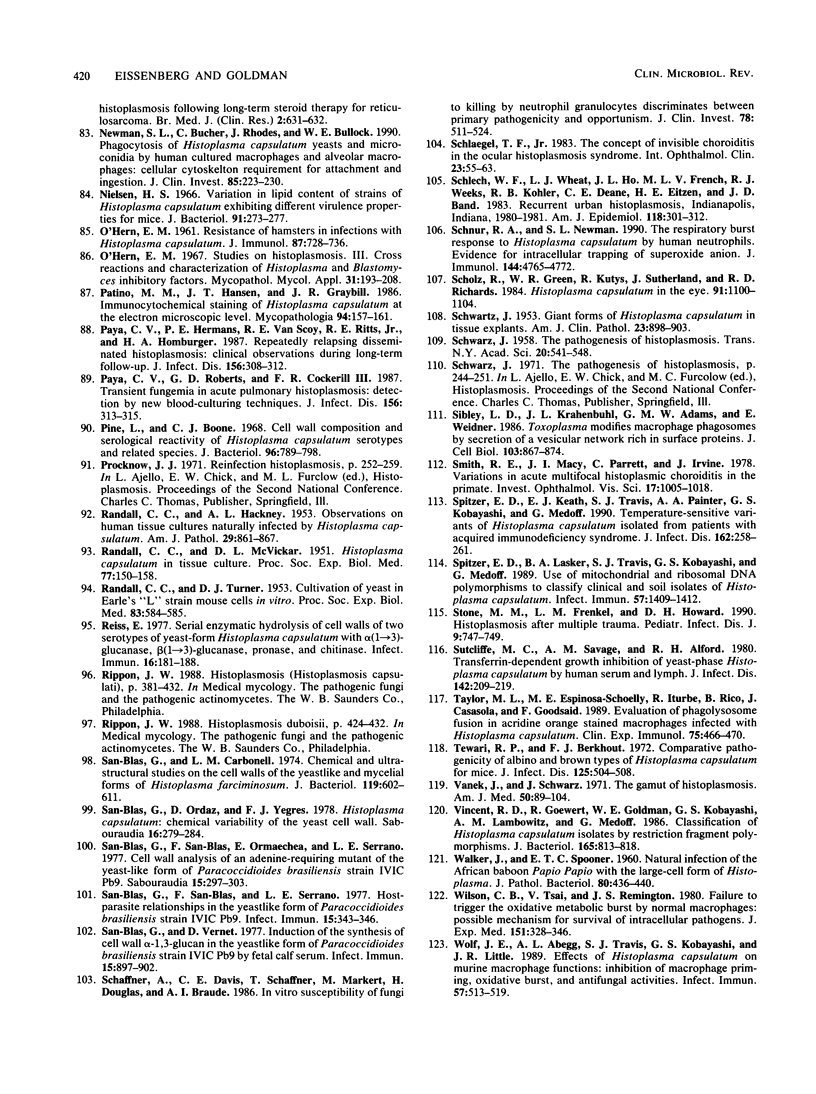
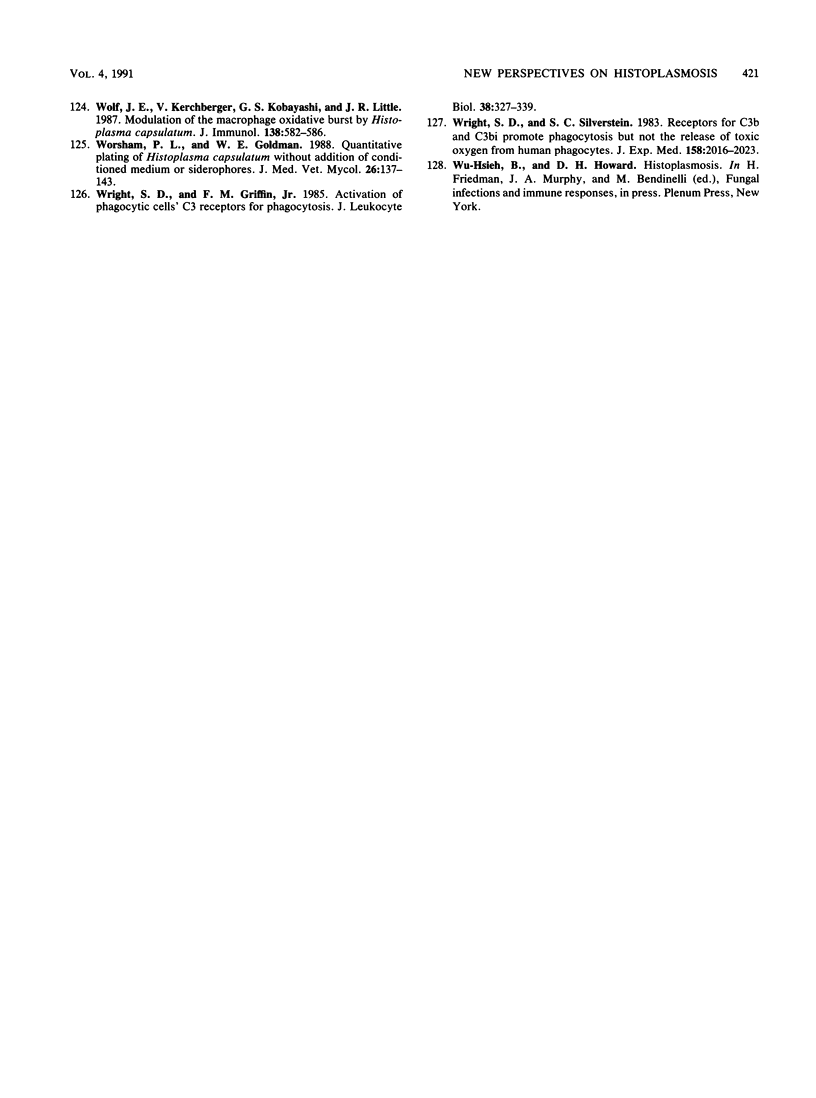
Selected References
These references are in PubMed. This may not be the complete list of references from this article.
- Anderson K. L., Marcus S. Variability in virulence of strains of Histoplasma capsulatum. Am Rev Respir Dis. 1969 Apr;99(4):608–609. doi: 10.1164/arrd.1969.99.4P1.608. [DOI] [PubMed] [Google Scholar]
- BINFORD C. H. Histoplasmosis: tissue reactions and morphologic variations of the fungus. Am J Clin Pathol. 1955 Jan;25(1):25–36. doi: 10.1093/ajcp/25.1.25. [DOI] [PubMed] [Google Scholar]
- Babior B. M. Oxygen-dependent microbial killing by phagocytes (first of two parts). N Engl J Med. 1978 Mar 23;298(12):659–668. doi: 10.1056/NEJM197803232981205. [DOI] [PubMed] [Google Scholar]
- Beaman B. L., Scates S. M., Moring S. E., Deem R., Misra H. P. Purification and properties of a unique superoxide dismutase from Nocardia asteroides. J Biol Chem. 1983 Jan 10;258(1):91–96. [PubMed] [Google Scholar]
- Berliner M. D. Histoplasma capsulatum: effects of pH on the yeast and mycelial phases in vitro. Sabouraudia. 1973 Nov;11(3):267–270. doi: 10.1080/00362177385190541. [DOI] [PubMed] [Google Scholar]
- Berliner M. D. Primary subcultures of Histoplasma capsulatum. I. Macro and micro-morphology of the mycelial phase. Sabouraudia. 1968 Feb;6(2):111–118. [PubMed] [Google Scholar]
- Boguslawski G., Akagi J. M., Ward L. G. Possible role for cysteine biosynthesis in conversion from mycelial to yeast form of Histoplasma capsulatum. Nature. 1976 May 27;261(5558):336–338. doi: 10.1038/261336a0. [DOI] [PubMed] [Google Scholar]
- Borok R. The mycelial status and reversibility in Histoplasma capsulatum. Sabouraudia. 1980 Dec;18(4):249–253. [PubMed] [Google Scholar]
- Braley R. E., Meredith T. A., Aaberg T. M., Koethe S. M., Witkowski J. A. The prevalence of HLA-B7 in presumed ocular histoplasmosis. Am J Ophthalmol. 1978 Jun;85(6):859–861. doi: 10.1016/s0002-9394(14)78118-8. [DOI] [PubMed] [Google Scholar]
- Bullock W. E., Wright S. D. Role of the adherence-promoting receptors, CR3, LFA-1, and p150,95, in binding of Histoplasma capsulatum by human macrophages. J Exp Med. 1987 Jan 1;165(1):195–210. doi: 10.1084/jem.165.1.195. [DOI] [PMC free article] [PubMed] [Google Scholar]
- Burt W. R. Identification of coprogen B and its breakdown products from Histoplasma capsulatum. Infect Immun. 1982 Mar;35(3):990–996. doi: 10.1128/iai.35.3.990-996.1982. [DOI] [PMC free article] [PubMed] [Google Scholar]
- Bus J. S., Gibson J. E. Mechanisms of superoxide radical-mediated toxicity. J Toxicol Clin Toxicol. 1982 Aug;19(6-7):689–697. doi: 10.3109/15563658208990398. [DOI] [PubMed] [Google Scholar]
- CAMPBELL C. C. THE EPIDEMIOLOGY OF HISTOPLASMOSIS. Ann Intern Med. 1965 Jun;62:1333–1336. doi: 10.7326/0003-4819-62-6-1333. [DOI] [PubMed] [Google Scholar]
- Calderone R. A., Peterson E. Inhibition of amino acid uptake and incorporation into Histoplasma capsulatum by a lysosomal extract from rabbit alveolar macrophages. J Reticuloendothel Soc. 1979 Jul;26(1):11–19. [PubMed] [Google Scholar]
- Campbell C. C., Berliner M. D. Virulence differences in mice of type A and B Histoplasma capsulatum yeasts grown in continuous light and total darkness. Infect Immun. 1973 Oct;8(4):677–678. doi: 10.1128/iai.8.4.677-678.1973. [DOI] [PMC free article] [PubMed] [Google Scholar]
- Chang K. P. Cellular and molecular mechanisms of intracellular symbiosis in leishmaniasis. Int Rev Cytol Suppl. 1983;14:267–305. [PubMed] [Google Scholar]
- Craig E. L., Suie T. Histoplasma capsulatum in human ocular tissue. Arch Ophthalmol. 1974 Apr;91(4):285–289. doi: 10.1001/archopht.1974.03900060295010. [DOI] [PubMed] [Google Scholar]
- DROUHET E., SCHWARZ J. Comparative studies with 18 strains of histoplasma; morphology in tissues and virulence of African and American strains. J Lab Clin Med. 1956 Jan;47(1):128–139. [PubMed] [Google Scholar]
- Davies S. F., Khan M., Sarosi G. A. Disseminated histoplasmosis in immunologically suppressed patients. Occurrence in a nonendemic area. Am J Med. 1978 Jan;64(1):94–100. doi: 10.1016/0002-9343(78)90183-3. [DOI] [PubMed] [Google Scholar]
- Domer J. E. Monosaccharide and chitin content of cell walls of Histoplasma capsulatum and Blastomyces dermatitidis. J Bacteriol. 1971 Sep;107(3):870–877. doi: 10.1128/jb.107.3.870-877.1971. [DOI] [PMC free article] [PubMed] [Google Scholar]
- Dumont A., Robert A. Electron microscopic study of phagocytosis of Histoplasma capsulatum by hamster peritoneal macrophages. Lab Invest. 1970 Sep;23(3):278–286. [PubMed] [Google Scholar]
- Eissenberg L. G., Goldman W. E. Histoplasma capsulatum fails to trigger release of superoxide from macrophages. Infect Immun. 1987 Jan;55(1):29–34. doi: 10.1128/iai.55.1.29-34.1987. [DOI] [PMC free article] [PubMed] [Google Scholar]
- Eissenberg L. G., Schlesinger P. H., Goldman W. E. Phagosome-lysosome fusion in P388D1 macrophages infected with Histoplasma capsulatum. J Leukoc Biol. 1988 Jun;43(6):483–491. doi: 10.1002/jlb.43.6.483. [DOI] [PubMed] [Google Scholar]
- Eissenberg L. G., West J. L., Woods J. P., Goldman W. E. Infection of P388D1 macrophages and respiratory epithelial cells by Histoplasma capsulatum: selection of avirulent variants and their potential role in persistent histoplasmosis. Infect Immun. 1991 May;59(5):1639–1646. doi: 10.1128/iai.59.5.1639-1646.1991. [DOI] [PMC free article] [PubMed] [Google Scholar]
- Feman S. S., Tilford R. H. Ocular findings in patients with histoplasmosis. JAMA. 1985 May 3;253(17):2534–2537. [PubMed] [Google Scholar]
- Filice G. A., Beaman B. L., Krick J. A., Remington J. S. Effects of human neutrophils and monocytes on Nocardia asteroides: failure of killing despite occurrence of the oxidative metabolic burst. J Infect Dis. 1980 Sep;142(3):432–438. doi: 10.1093/infdis/142.3.432. [DOI] [PubMed] [Google Scholar]
- Gass M., Kobayashi G. S. Histoplasmosis. An illustrative case with unusual vaginal and joint involvement. Arch Dermatol. 1969 Dec;100(6):724–727. doi: 10.1001/archderm.100.6.724. [DOI] [PubMed] [Google Scholar]
- Geisow M. J. Fluorescein conjugates as indicators of subcellular pH. A critical evaluation. Exp Cell Res. 1984 Jan;150(1):29–35. doi: 10.1016/0014-4827(84)90698-0. [DOI] [PubMed] [Google Scholar]
- Godfrey W. A., Sabates R., Cross D. E. Association of presumed ocular histoplasmosis with HLA-B7. Am J Ophthalmol. 1978 Jun;85(6):854–858. doi: 10.1016/s0002-9394(14)78117-6. [DOI] [PubMed] [Google Scholar]
- Goldstein B. G., Buettner H. Histoplasmic endophthalmitis. A clinicopathologic correlation. Arch Ophthalmol. 1983 May;101(5):774–777. doi: 10.1001/archopht.1983.01040010774016. [DOI] [PubMed] [Google Scholar]
- Goodman D. H. Systemic fungal infection complications in asthmatic patients treated with steroids. Ann Allergy. 1973 Apr;31(4):205–208. [PubMed] [Google Scholar]
- Goodman N. L., Larsh H. W. Environmental factors and growth of Histoplasma capsulatum in soil. Mycopathol Mycol Appl. 1967 Nov 13;33(2):145–156. doi: 10.1007/BF02053445. [DOI] [PubMed] [Google Scholar]
- Goodwin R. A., Jr, Owens F. T., Snell J. D., Hubbard W. W., Buchanan R. D., Terry R. T., Des Prez R. M. Chronic pulmonary histoplasmosis. Medicine (Baltimore) 1976 Nov;55(6):413–452. doi: 10.1097/00005792-197611000-00001. [DOI] [PubMed] [Google Scholar]
- Gordon A. H., Hart P. D., Young M. R. Ammonia inhibits phagosome-lysosome fusion in macrophages. Nature. 1980 Jul 3;286(5768):79–80. doi: 10.1038/286079a0. [DOI] [PubMed] [Google Scholar]
- Graybill J. R. Histoplasmosis and AIDS. J Infect Dis. 1988 Sep;158(3):623–626. doi: 10.1093/infdis/158.3.623. [DOI] [PubMed] [Google Scholar]
- HINTON A., LARSH H. W., SILBERG S. L. Conversion and maintenance of Histoplasma capsulatum in tissue culture. Proc Soc Exp Biol Med. 1956 Dec;93(3):612–615. doi: 10.3181/00379727-93-22838. [DOI] [PubMed] [Google Scholar]
- HOWARD D. H. INTRACELLULAR BEHAVIOR OF HISTOPLASMA CAPSULATUM. J Bacteriol. 1964 Jan;87:33–38. doi: 10.1128/jb.87.1.33-38.1964. [DOI] [PMC free article] [PubMed] [Google Scholar]
- HOWARD D. H. INTRACELLULAR GROWTH OF HISTOPLASMA CAPSULATUM. J Bacteriol. 1965 Feb;89:518–523. doi: 10.1128/jb.89.2.518-523.1965. [DOI] [PMC free article] [PubMed] [Google Scholar]
- HOWELL A., Jr, KIPKIE G. F. Studies on experimental histoplasmosis. IV. A comparison of the virulence of five strains of histoplasma capsulatum by intracerebral inoculation of male dba line 1 mice. J Lab Clin Med. 1950 Oct;36(4):547–554. [PubMed] [Google Scholar]
- Heiple J. M., Taylor D. L. pH changes in pinosomes and phagosomes in the ameba, Chaos carolinensis. J Cell Biol. 1982 Jul;94(1):143–149. doi: 10.1083/jcb.94.1.143. [DOI] [PMC free article] [PubMed] [Google Scholar]
- Hempel H., Goodman N. L. Rapid conversion of Histoplasma capsulatum, Blastomyces dermatitidis and sporothrix schenckii in tissue culture. J Clin Microbiol. 1975 May;1(5):420–424. doi: 10.1128/jcm.1.5.420-424.1975. [DOI] [PMC free article] [PubMed] [Google Scholar]
- Howard D. H. Comparative sensitivity of Histoplasma capsulatum conidiospores and blastospores to oxidative antifungal systems. Infect Immun. 1981 Apr;32(1):381–387. doi: 10.1128/iai.32.1.381-387.1981. [DOI] [PMC free article] [PubMed] [Google Scholar]
- Howard D. H., Dabrowa N., Otto V., Rhodes J. Cysteine transport and sulfite reductase activity in a germination-defective mutant of Histoplasma capsulatum. J Bacteriol. 1980 Jan;141(1):417–421. doi: 10.1128/jb.141.1.417-421.1980. [DOI] [PMC free article] [PubMed] [Google Scholar]
- Howard D. H. Fate of Histoplasma capsulatum in guinea pig polymorphonuclear leukocytes. Infect Immun. 1973 Sep;8(3):412–419. doi: 10.1128/iai.8.3.412-419.1973. [DOI] [PMC free article] [PubMed] [Google Scholar]
- Howard D. H. Further studies on the inhibition of Histoplasma capsulatum within macrophages from immunized animals. Infect Immun. 1973 Oct;8(4):577–581. doi: 10.1128/iai.8.4.577-581.1973. [DOI] [PMC free article] [PubMed] [Google Scholar]
- Howard D. H. Studies on the catalase of Histoplasma capsulatum. Infect Immun. 1983 Mar;39(3):1161–1166. doi: 10.1128/iai.39.3.1161-1166.1983. [DOI] [PMC free article] [PubMed] [Google Scholar]
- Hutton J. P., Durham J. B., Miller D. P., Everett E. D. Hyphal forms of Histoplasma capsulatum. A common manifestation of intravascular infections. Arch Pathol Lab Med. 1985 Apr;109(4):330–332. [PubMed] [Google Scholar]
- Jimenez-Lucho V., Ginsburg V., Krivan H. C. Cryptococcus neoformans, Candida albicans, and other fungi bind specifically to the glycosphingolipid lactosylceramide (Gal beta 1-4Glc beta 1-1Cer), a possible adhesion receptor for yeasts. Infect Immun. 1990 Jul;58(7):2085–2090. doi: 10.1128/iai.58.7.2085-2090.1990. [DOI] [PMC free article] [PubMed] [Google Scholar]
- Johnston R. B., Jr Oxygen metabolism and the microbicidal activity of macrophages. Fed Proc. 1978 Nov;37(13):2759–2764. [PubMed] [Google Scholar]
- Kabli S., Koschmann J. R., Robertstad G. W., Lawrence J., Ajello L., Redetzke K. Endemic canine and feline histoplasmosis in El Paso, Texas. J Med Vet Mycol. 1986 Feb;24(1):41–50. doi: 10.1080/02681218680000051. [DOI] [PubMed] [Google Scholar]
- Kanetsuna F., Carbonell L. M., Gil F., Azuma I. Chemical and ultrastructural studies on the cell walls of the yeastlike and mycelial forms of Histoplasma capsulatum. Mycopathol Mycol Appl. 1974 Oct 15;54(1):1–13. doi: 10.1007/BF02055967. [DOI] [PubMed] [Google Scholar]
- Kimberlin C. L., Hariri A. R., Hempel H. O., Goodman N. L. Interactions between Histoplasma capsulatum and macrophages from normal and treated mice: comparison of the mycelial and yeast phases in alveolar and peritoneal macrophages. Infect Immun. 1981 Oct;34(1):6–10. doi: 10.1128/iai.34.1.6-10.1981. [DOI] [PMC free article] [PubMed] [Google Scholar]
- Klimpel K. R., Goldman W. E. Cell walls from avirulent variants of Histoplasma capsulatum lack alpha-(1,3)-glucan. Infect Immun. 1988 Nov;56(11):2997–3000. doi: 10.1128/iai.56.11.2997-3000.1988. [DOI] [PMC free article] [PubMed] [Google Scholar]
- Klimpel K. R., Goldman W. E. Isolation and characterization of spontaneous avirulent variants of Histoplasma capsulatum. Infect Immun. 1987 Mar;55(3):528–533. doi: 10.1128/iai.55.3.528-533.1987. [DOI] [PMC free article] [PubMed] [Google Scholar]
- Kumar V., Maresca B., Sacco M., Goewert R., Kobayashi G. S., Medoff G. Purification and characterization of a cysteine dioxygenase from the yeast phase of Histoplasma capsulatum. Biochemistry. 1983 Feb 15;22(4):762–768. doi: 10.1021/bi00273a009. [DOI] [PubMed] [Google Scholar]
- Kurtin P. J., McKinsey D. S., Gupta M. R., Driks M. Histoplasmosis in patients with acquired immunodeficiency syndrome. Hematologic and bone marrow manifestations. Am J Clin Pathol. 1990 Mar;93(3):367–372. doi: 10.1093/ajcp/93.3.367. [DOI] [PubMed] [Google Scholar]
- Kwon-Chung K. J., Bartlett M. S., Wheat L. J. Distribution of the two mating types among Histoplasma capsulatum isolates obtained from an urban histoplasmosis outbreak. Sabouraudia. 1984;22(2):155–157. [PubMed] [Google Scholar]
- Kwon-Chung K. J., Weeks R. J., Larsh H. W. Studies on Emmonsiella capsulata (Histoplasma capsulatum). II. Distribution of the two mating types in 13 endemic states of the United States. Am J Epidemiol. 1974 Jan;99(1):44–49. doi: 10.1093/oxfordjournals.aje.a121583. [DOI] [PubMed] [Google Scholar]
- LOURIA D. B., FEDER N., MITCHELL W., EMMONS C. W. Influence of fungus strain and lapse of time in experimental histoplasmosis and of volume of inoculum in cryptococcosis upon recovery of the fungi. J Lab Clin Med. 1959 Feb;53(2):311–317. [PubMed] [Google Scholar]
- MARIAT F., SEGRETAIN G. Etude mycologique d'une histoplasmose spontanée du singe africain, Cynocephalus babuin. Ann Inst Pasteur (Paris) 1956 Dec;91(6):874–891. [PubMed] [Google Scholar]
- MOORE M. Morphologic variation in tissue of the organisms of the blastomycoses and of histoplasmosis. Am J Pathol. 1955 Nov-Dec;31(6):1049–1063. [PMC free article] [PubMed] [Google Scholar]
- Mahvi T. A. Factors governing the epidemiology of Histoplasma capsulatum in soil. Mycopathol Mycol Appl. 1970;41(1):167–176. doi: 10.1007/BF02051492. [DOI] [PubMed] [Google Scholar]
- Makley T. A., Craig E. L., Werling K. Histopathology of ocular histoplasmosis. Int Ophthalmol Clin. 1983 Summer;23(2):1–18. doi: 10.1097/00004397-198302320-00003. [DOI] [PubMed] [Google Scholar]
- Mandell W., Goldberg D. M., Neu H. C. Histoplasmosis in patients with the acquired immune deficiency syndrome. Am J Med. 1986 Dec;81(6):974–978. doi: 10.1016/0002-9343(86)90390-6. [DOI] [PubMed] [Google Scholar]
- Maresca B., Jacobson E., Medoff G., Kobayashi G. Cystine reductase in the dimorphic fungus Histoplasma capsulatum. J Bacteriol. 1978 Sep;135(3):987–992. doi: 10.1128/jb.135.3.987-992.1978. [DOI] [PMC free article] [PubMed] [Google Scholar]
- Maresca B., Lambowitz A. M., Kumar V. B., Grant G. A., Kobayashi G. S., Medoff G. Role of cysteine in regulating morphogenesis and mitochondrial activity in the dimorphic fungus Histoplasma capsulatum. Proc Natl Acad Sci U S A. 1981 Jul;78(7):4596–4600. doi: 10.1073/pnas.78.7.4596. [DOI] [PMC free article] [PubMed] [Google Scholar]
- McNeil P. L., Tanasugarn L., Meigs J. B., Taylor D. L. Acidification of phagosomes is initiated before lysosomal enzyme activity is detected. J Cell Biol. 1983 Sep;97(3):692–702. doi: 10.1083/jcb.97.3.692. [DOI] [PMC free article] [PubMed] [Google Scholar]
- Medoff G., Kobayashi G. S., Painter A., Travis S. Morphogenesis and pathogenicity of Histoplasma capsulatum. Infect Immun. 1987 Jun;55(6):1355–1358. doi: 10.1128/iai.55.6.1355-1358.1987. [DOI] [PMC free article] [PubMed] [Google Scholar]
- Medoff G., Maresca B., Lambowitz A. M., Kobayashi G., Painter A., Sacco M., Carratu L. Correlation between pathogenicity and temperature sensitivity in different strains of Histoplasma capsulatum. J Clin Invest. 1986 Dec;78(6):1638–1647. doi: 10.1172/JCI112757. [DOI] [PMC free article] [PubMed] [Google Scholar]
- Menges R. W., Furcolow M. L., Selby L. A., Habermann R. T., Smith C. D. Ecologic studies of histoplasmosis. Am J Epidemiol. 1967 Jan;85(1):108–119. doi: 10.1093/oxfordjournals.aje.a120668. [DOI] [PubMed] [Google Scholar]
- Meredith T. A., Smith R. E., Duquesnoy R. J. Association of HLA-DRw2 antigen with presumed ocular histoplasmosis. Am J Ophthalmol. 1980 Jan;89(1):70–76. doi: 10.1016/0002-9394(80)90232-9. [DOI] [PubMed] [Google Scholar]
- Morris P. R., Terreni A. A., DiSalvo A. F. Red-pigmented Histoplasma capsulatum--an unusual variant. J Med Vet Mycol. 1986 Jun;24(3):231–233. [PubMed] [Google Scholar]
- Newman S. L., Bucher C., Rhodes J., Bullock W. E. Phagocytosis of Histoplasma capsulatum yeasts and microconidia by human cultured macrophages and alveolar macrophages. Cellular cytoskeleton requirement for attachment and ingestion. J Clin Invest. 1990 Jan;85(1):223–230. doi: 10.1172/JCI114416. [DOI] [PMC free article] [PubMed] [Google Scholar]
- Nielsen H. S. Variation in Lipid Content of Strains of Histoplasma capsulatum Exhibiting Different Virulence Properties for Mice. J Bacteriol. 1966 Jan;91(1):273–277. doi: 10.1128/jb.91.1.273-277.1966. [DOI] [PMC free article] [PubMed] [Google Scholar]
- O'HERN E. M. Resistance of hamsters in infections with Histoplasma capsulatum. J Immunol. 1961 Dec;87:728–736. [PubMed] [Google Scholar]
- O'Hern E. M. Studies in histoplasmosis. 3. Cross reactions and characterization of Histoplasma and Blastomyces inhibitory factors. Mycopathol Mycol Appl. 1967 Apr 28;31(3):193–208. doi: 10.1007/BF02053417. [DOI] [PubMed] [Google Scholar]
- Patino M. M., Hansen J. T., Graybill J. R. Immunocytochemical staining of Histoplasma capsulatum at the electron microscopic level. Mycopathologia. 1986 Jun;94(3):157–161. doi: 10.1007/BF00454594. [DOI] [PubMed] [Google Scholar]
- Paya C. V., Hermans P. E., Van Scoy R. E., Ritts R. E., Jr, Homburger H. A. Repeatedly relapsing disseminated histoplasmosis: clinical observations during long-term follow-up. J Infect Dis. 1987 Aug;156(2):308–312. doi: 10.1093/infdis/156.2.308. [DOI] [PubMed] [Google Scholar]
- Paya C. V., Roberts G. D., Cockerill F. R., 3rd Transient fungemia in acute pulmonary histoplasmosis: detection by new blood-culturing techniques. J Infect Dis. 1987 Aug;156(2):313–315. doi: 10.1093/infdis/156.2.313. [DOI] [PubMed] [Google Scholar]
- Pine L., Boone C. J. Cell wall composition and serological reactivity of Histoplasma capsulatum serotypes and related species. J Bacteriol. 1968 Sep;96(3):789–798. doi: 10.1128/jb.96.3.789-798.1968. [DOI] [PMC free article] [PubMed] [Google Scholar]
- RANDALL C. C., HACKNEY A. L. Observations on human tissue cultures naturally infected by Histoplasma capsulatum. Am J Pathol. 1953 Sep-Oct;29(5):861–869. [PMC free article] [PubMed] [Google Scholar]
- RANDALL C. C., McVICKAR D. L. Histoplasma capsulatum in tissue culture. Proc Soc Exp Biol Med. 1951 May;77(1):150–153. doi: 10.3181/00379727-77-18708. [DOI] [PubMed] [Google Scholar]
- RANDALL C. C., TURNER D. J. Cultivation of yeast in Earle's L strain mouse cells in vitro. Proc Soc Exp Biol Med. 1953 Jul;83(3):584–585. doi: 10.3181/00379727-83-20425. [DOI] [PubMed] [Google Scholar]
- Reiss E. Serial enzymatic hydrolysis of cell walls of two serotypes of yeast-form Histoplasma capsulatum with alpha(1 leads to 3)-glucanase, beta(1 leads to 3)-glucanase, pronase, and chitinase. Infect Immun. 1977 Apr;16(1):181–188. doi: 10.1128/iai.16.1.181-188.1977. [DOI] [PMC free article] [PubMed] [Google Scholar]
- SCHWARZ J. Ginat forms of Histoplasma capsulatum in tissue explants. Am J Clin Pathol. 1953 Sep;23(9):898–903. doi: 10.1093/ajcp/23.9.898. [DOI] [PubMed] [Google Scholar]
- SCHWARZ J. The pathogenesis of histoplasmosis. Trans N Y Acad Sci. 1958 Apr;20(6):541–548. doi: 10.1111/j.2164-0947.1958.tb00618.x. [DOI] [PubMed] [Google Scholar]
- San-Blas G., Carbonell L. M. Chemical and ultrastructural studies on the cell walls of the yeastlike and mycelial forms of Histoplasma farciminosum. J Bacteriol. 1974 Aug;119(2):602–611. doi: 10.1128/jb.119.2.602-611.1974. [DOI] [PMC free article] [PubMed] [Google Scholar]
- San-Blas G., Ordaz D., Yegres F. J. Histoplasma capsulatum: chemical variability of the yeast cell wall. Sabouraudia. 1978 Dec;16(4):279–284. doi: 10.1080/00362177885380381. [DOI] [PubMed] [Google Scholar]
- San-Blas G., San-Blas F., Ormaechea E., Serrano L. E. Cell wall analysis of an adenine-requiring mutant of the yeast-like form of Paracoccidioides brasiliensis strain IVIC Pb9. Sabouraudia. 1977 Nov;15(3):297–303. doi: 10.1080/00362177785380121. [DOI] [PubMed] [Google Scholar]
- San-Blas G., San-Blas F., Serrano L. E. Host-parasite relationships in the yeastlike form of Paracoccidioides brasiliensis strain IVIC Pb9. Infect Immun. 1977 Feb;15(2):343–346. doi: 10.1128/iai.15.2.343-346.1977. [DOI] [PMC free article] [PubMed] [Google Scholar]
- San-Blas G., Vernet D. Induction of the synthesis of cell wall alpha-1,3-glucan in the yeastlike form of Paracoccidioides brasiliensis strain IVIC Pb9 by fetal calf serum. Infect Immun. 1977 Mar;15(3):897–902. doi: 10.1128/iai.15.3.897-902.1977. [DOI] [PMC free article] [PubMed] [Google Scholar]
- Schaffner A., Davis C. E., Schaffner T., Markert M., Douglas H., Braude A. I. In vitro susceptibility of fungi to killing by neutrophil granulocytes discriminates between primary pathogenicity and opportunism. J Clin Invest. 1986 Aug;78(2):511–524. doi: 10.1172/JCI112603. [DOI] [PMC free article] [PubMed] [Google Scholar]
- Schlaegel T. F., Jr The concept of invisible choroiditis in the ocular histoplasmosis syndrome. Int Ophthalmol Clin. 1983 Summer;23(2):55–63. doi: 10.1097/00004397-198302320-00007. [DOI] [PubMed] [Google Scholar]
- Schlech W. F., 3rd, Wheat L. J., Ho J. L., French M. L., Weeks R. J., Kohler R. B., Deane C. E., Eitzen H. E., Band J. D. Recurrent urban histoplasmosis, Indianapolis, Indiana, 1980-1981. Am J Epidemiol. 1983 Sep;118(3):301–312. doi: 10.1093/oxfordjournals.aje.a113637. [DOI] [PubMed] [Google Scholar]
- Schnur R. A., Newman S. L. The respiratory burst response to Histoplasma capsulatum by human neutrophils. Evidence for intracellular trapping of superoxide anion. J Immunol. 1990 Jun 15;144(12):4765–4772. [PubMed] [Google Scholar]
- Scholz R., Green W. R., Kutys R., Sutherland J., Richards R. D. Histoplasma capsulatum in the eye. Ophthalmology. 1984 Sep;91(9):1100–1104. doi: 10.1016/s0161-6420(84)34190-2. [DOI] [PubMed] [Google Scholar]
- Sibley L. D., Krahenbuhl J. L., Adams G. M., Weidner E. Toxoplasma modifies macrophage phagosomes by secretion of a vesicular network rich in surface proteins. J Cell Biol. 1986 Sep;103(3):867–874. doi: 10.1083/jcb.103.3.867. [DOI] [PMC free article] [PubMed] [Google Scholar]
- Smith R. E., Macy J. I., Parrett C., Irvine J. Variations in acute multifocal histoplasmic choroiditis in the primate. Invest Ophthalmol Vis Sci. 1978 Oct;17(10):1005–1018. [PubMed] [Google Scholar]
- Spitzer E. D., Keath E. J., Travis S. J., Painter A. A., Kobayashi G. S., Medoff G. Temperature-sensitive variants of Histoplasma capsulatum isolated from patients with acquired immunodeficiency syndrome. J Infect Dis. 1990 Jul;162(1):258–261. doi: 10.1093/infdis/162.1.258. [DOI] [PubMed] [Google Scholar]
- Spitzer E. D., Lasker B. A., Travis S. J., Kobayashi G. S., Medoff G. Use of mitochondrial and ribosomal DNA polymorphisms to classify clinical and soil isolates of Histoplasma capsulatum. Infect Immun. 1989 May;57(5):1409–1412. doi: 10.1128/iai.57.5.1409-1412.1989. [DOI] [PMC free article] [PubMed] [Google Scholar]
- Stone M. M., Frenkel L. M., Howard D. H. Histoplasmosis after multiple trauma. Pediatr Infect Dis J. 1990 Oct;9(10):747–749. [PubMed] [Google Scholar]
- Sutcliffe M. C., Savage A. M., Alford R. H. Transferrin-dependent growth inhibition of yeast-phase Histoplasma capsulatum by human serum and lymph. J Infect Dis. 1980 Aug;142(2):209–219. doi: 10.1093/infdis/142.2.209. [DOI] [PubMed] [Google Scholar]
- Taylor M. L., Espinosa-Schoelly M. E., Iturbe R., Rico B., Casasola J., Goodsaid F. Evaluation of phagolysosome fusion in acridine orange stained macrophages infected with Histoplasma capsulatum. Clin Exp Immunol. 1989 Mar;75(3):466–470. [PMC free article] [PubMed] [Google Scholar]
- Tewari R. P., Berkhout F. J. Comparative pathogenicity of albino and brown types of Histoplasma capsulatum for mice. J Infect Dis. 1972 May;125(5):504–508. doi: 10.1093/infdis/125.5.504. [DOI] [PubMed] [Google Scholar]
- Vanek J., Schwarz J. The gamut of histoplasmosis. Am J Med. 1971 Jan;50(1):89–104. doi: 10.1016/0002-9343(71)90208-7. [DOI] [PubMed] [Google Scholar]
- Vincent R. D., Goewert R., Goldman W. E., Kobayashi G. S., Lambowitz A. M., Medoff G. Classification of Histoplasma capsulatum isolates by restriction fragment polymorphisms. J Bacteriol. 1986 Mar;165(3):813–818. doi: 10.1128/jb.165.3.813-818.1986. [DOI] [PMC free article] [PubMed] [Google Scholar]
- WALKER J., SPOONER E. T. Natural infection of the African baboon Papio papio with the large-cell form of Histoplasma. J Pathol Bacteriol. 1960 Oct;80:436–438. [PubMed] [Google Scholar]
- Wilson C. B., Tsai V., Remington J. S. Failure to trigger the oxidative metabolic burst by normal macrophages: possible mechanism for survival of intracellular pathogens. J Exp Med. 1980 Feb 1;151(2):328–346. doi: 10.1084/jem.151.2.328. [DOI] [PMC free article] [PubMed] [Google Scholar]
- Wolf J. E., Abegg A. L., Travis S. J., Kobayashi G. S., Little J. R. Effects of Histoplasma capsulatum on murine macrophage functions: inhibition of macrophage priming, oxidative burst, and antifungal activities. Infect Immun. 1989 Feb;57(2):513–519. doi: 10.1128/iai.57.2.513-519.1989. [DOI] [PMC free article] [PubMed] [Google Scholar]
- Wolf J. E., Kerchberger V., Kobayashi G. S., Little J. R. Modulation of the macrophage oxidative burst by Histoplasma capsulatum. J Immunol. 1987 Jan 15;138(2):582–586. [PubMed] [Google Scholar]
- Worsham P. L., Goldman W. E. Quantitative plating of Histoplasma capsulatum without addition of conditioned medium or siderophores. J Med Vet Mycol. 1988 Jun;26(3):137–143. [PubMed] [Google Scholar]
- Wright S. D., Griffin F. M., Jr Activation of phagocytic cells' C3 receptors for phagocytosis. J Leukoc Biol. 1985 Aug;38(2):327–339. doi: 10.1002/jlb.38.2.327. [DOI] [PubMed] [Google Scholar]
- Wright S. D., Silverstein S. C. Receptors for C3b and C3bi promote phagocytosis but not the release of toxic oxygen from human phagocytes. J Exp Med. 1983 Dec 1;158(6):2016–2023. doi: 10.1084/jem.158.6.2016. [DOI] [PMC free article] [PubMed] [Google Scholar]


